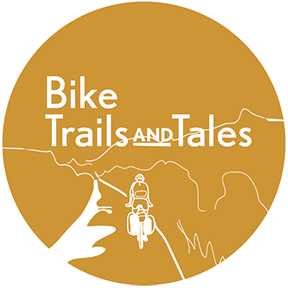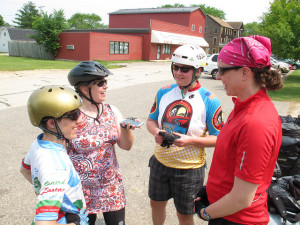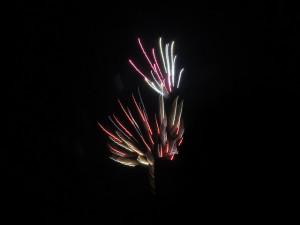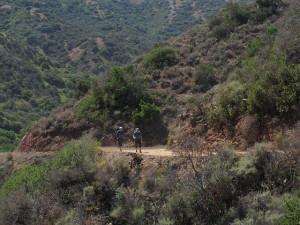This past weekend, I joined 4 others on an informal trip to Wisconsin’s Elroy- Sparta Trail and La Crosse River State Trail. The Elroy-Sparta has the distinction of being America’s first rails to trails project, established in 1965, making this year its 50th anniversary!
The trail itself is about 32 miles long, and connects with several other trails, including the La Crosse, in an interrupted chain of about 100 miles. We didn’t have time to plan for or do a full out and back of the entire chain of trails, so our itinerary for the weekend, just finalized a couple weeks prior, was as follows:
- Day 1: Arrive at Elroy Commons, park our cars, and bike 32 miles to Sparta. For lodging, we planned on “bike-packing,” that is, carrying all of our camping gear in panniers and staying at the Department of Natural Resources (DNR) campground in Sparta;
- Day 2: Depart from Sparta on bike, ride part of the La Crosse River State Trail for an out and back trip, returning to the Sparta DNR campground for the evening (round trip total ~ 30 miles); and
- Day 3: Depart from Sparta and bike back to Elroy Commons to our cars – 32 miles.
In addition to myself, those on the trip included Lauren, Ellen, Autumn, and Yesica (with Yesica taking all of the great pics posted here!). On July 3, we met early in the morning, packed up the cars, and made the drive to Elroy, Wisconsin. Upon reaching Elroy, we easily found the Elroy Commons, which is the start/finish of both the Elroy-Sparta Trail and the 400 State Trail. There, we were able to buy trail passes for the entire weekend, which are required for riding the trail:
After eating breakfast (for lunch) at a diner in Elroy, we were eager to get on the trail and begin the day’s ride! Here we are, being led in a pre-ride voice recording by Ellen:
Before we knew it, we were on the trail. For me, it felt great to just be outside, riding. I work at a desk job all day, and it doesn’t always suit my personality and desired activity level. Also, I noticed right away that the trail was in great condition. The surface is sort of a packed, crushed stone and it had few bumps and holes (quite unlike the C&O Towpath experience!). Surprisingly, the trail wasn’t all that crowded, and I wondered if that was unusual for a holiday weekend.
Soon enough, we came across the first tunnel of three:
We found it quite cool and entertaining. Obviously, upon entering a tunnel, it is necessary to make various hoot and hollering noises. Also, according to a sign, we were required to get off our bikes and walk them through the tunnel, due to the wet, bumpy surface and lack of light. If one didn’t have a light, it would be difficult to pass. Look at how scary it would be:
Not to worry though, we made it through in no time:
We continued riding and stopped for a short break at a rest area off the trail. There, we ran into more trouble:
Bike trips can be quite dangerous. We encountered two more tunnels along the way, including the final one, which was over 3000 feet long and in which we couldn’t see the end when we entered it. Inside the tunnels, it was at least 20 degrees cooler than outside, and the walls and ceiling were dripping with water.
Fortunately, we made it to the Sparta DNR campground while the sun was still out. I’d like to say that we then peacefully set up our tents and enjoyed a long, enjoyable night around the campfire. However, upon entering the DNR site, we were immediately swarmed by mosquitoes, despite practically emptying bottles of bug spray over ourselves. So, we quickly ate dinner and retired to our tents, where it was (mostly) safe. We all had many mosquito bites, including several of us with bites on our faces and eyelids (awkward).
The next morning, we ate a quick breakfast at camp and then decided to depart for the day, not to return until bedtime (due to the mosquitoes). The plan for the day was to ride a bit on the La Cross River State Trail, which runs about 22 miles from Sparta to La Crosse, WI, and then return to Sparta in time for the town’s 4th of July celebration.
So, after leaving our campground in Sparta and getting back on the trail, we quickly encountered the Sparta Depot:
We rode for about 10 miles on the La Crosse River Trail, which was also a quite nice trail. It traverses through farm land and small towns, and it seemed to not have as much tree cover as the Sparta Elroy Trail. We also rode past these giant mounds of sand. It actually wasn’t clear what these big mounds were, or what exactly went on at this sand factory, but “sand factory” seemed like the best guess:
At Bangor, WI, we arrived at a park just off the trail, where people were setting up 4th of July festivities. These festivities included grilling large amounts of meat on massive grills, fishing in a local stream, playing bingo, and shooting guns at a shooting range at the park. The park also had a veterans’ memorial, complete with a helicopter and tank, which we had to check out:
We stopped here for a couple of hours and ate lunch, rested, and played cards. It was a bit hard to relax too much, due to the continual shooting (I think Ellen has a recording of what it sounded like there), but it was still a nice break. After hanging out in Bangor, we decided to head back to Sparta for some important business meetings.
First up, we had to stop by Ben Bikin’s place and convince him to stay in Sparta:
Then, we had to stop by the legendary Lynda Lou’s in Sparta, for some competitive shuffleboard, Spotted Cow beer drinking, and Jenga-playing:
We also spent quite a bit of time at Memorial Park in Sparta, which was having a 4th of July celebration. Various tents were set up, including an especially popular one that sold apple pie, frozen custard, and root beer floats. Nearby was a water park, where we were all grateful to be able to take showers (side note: it’s a good thing, too, because when Lauren washed her hair, a large beetle fell out).
The fireworks display started shortly before 10 pm, and we watched them for a bit, before riding our bikes back to the campsite:
Upon reaching our campsites, we quickly hung our food and then hopped into our tents before the mosquitoes could get us too badly. All of the other DNR spots seemed taken at this point, something I think we were all slightly worried about before the trip. The DNR sites are first-come, first-served, and reservations are not accepted. So, planning a bike trip around staying at such sites can be somewhat risky, especially as based on my research prior to the trip, many commercial campsites had 3-night minimum stays over weekends and holidays. Luckily, it worked out for us, although I think we could have figured something out had the site been full.
The next morning, we broke camp in record time and, one by one, we gathered at the trail to begin the ride from Sparta back to Elroy. I would have been happy to have a few more days riding, so it was hard not to be a little sad about it being the last day. However, we still had a full day ahead of us, so I tried not to dwell on that:
We had a nice ride back to Sparta, making pretty good time. The pattern of the trail is that it’s somewhat rolling (for a rail trail), with the 3 tunnels being at the peaks. Periods of climbing are eventually followed by periods of downhills.
Overall it was a great trip:
Our total mileage was about 96!





































Recent Comments